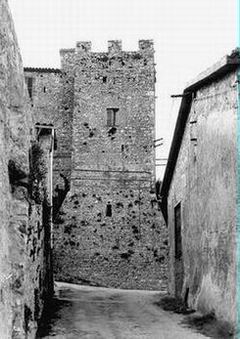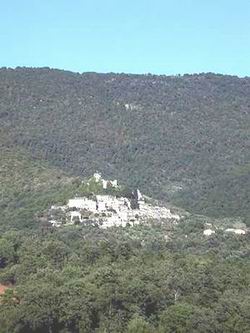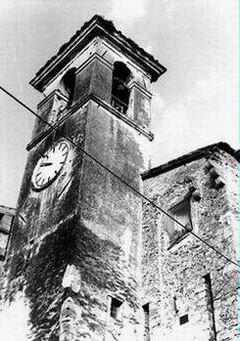Todi's country
Villa, Colpetrazzo e Mezzanelli i tre paesi belli
Villa = Villa San Faustino
The
Saint castle of Villa Faustino made part in centuries X and XI of the
Arnolfe lands and is cited in some documents of the abbey of Farfa of 1115
and 1118, was connected with the important pieve of Saint Faustino, one of
immensest of the diocese of Todi.
In century XIII it was incorporated in the peasantry of Todi and in the day of Saint Faustino you a great fair was carried out a lot that in the charter of Todi of the 1275 come established to send to this festivity a judge of the " malefizi " with a notary public and one armed supply in order to guarantee the public order.
Colpetrazzo
Castle constructed between the end of the 1300 and first years of the 1400, still intact conserve its medioevale, remarkable structure the door of entrance beyond which the small church of Saint Bernardino is found, ancient parochial of the castle.
Over the church of Saint Bernardino the ancient room of the confraternita one of the Saintest Sacramento deserves a visit, entire decorated with a precious cycle of it frescoes votives of the second goal of the 1400 and the first years of the 1500.
As
soon as outside from it walls castellane the parochial church is found,
dedicated to the Saints Giuseppe and Bernardino, built up in century XVI
and that conserve some burlaps of the 1600 attributable ones to painters
umbrians of the age.
Mezzanelli
The
castle made part of the feudo of the Arnolfi and is cited in some
documents of 1115 and 1118 with which the accounts Ridolfo, Saraceno,
Guillelmus, Hugolino, Tebaldo and Bulgarello yielded part of Mezzanelli
and others they properties
to Abbot Beraldo di Farfa;
it belonged to the Counts
of Baschi
therefore passed in part under the dominion of
Duchi Cesi.
Located in strategic position it was more times attached from Spoleto and from Todi cities in the course of the fights between Guelfi and Ghibellines, it endured destructions in the 1447 and the 1451. In the 1467 it was restored with the competition of all its inhabitants that to be make a duty for this occasion . In the 1500 approximately newly it was attacked from the troops of Pope Alexander VI that they destroyed the rocca.
Of remarkable the parochial church of Saint Filippo and San Giacomo and the ruines of the rocca.

La villa

Mezzanelli

Colpetrazzo
Villa = Villa San Faustino
Il castello di Villa San Faustino fece parte nei secoli X e XI delle terre Arnolfe ed è citato in alcuni documenti dell'abbazia di Farfa del 1115 e il 1118, era collegato con l'importante pieve di San Faustino, uno delle più vaste della diocesi di Todi.
Nel
XIII secolo fu incorporata nel contado di Todi, e fu stabilito
che nel giorno di San Faustino , fosse indetta una
grande fiera a cui dovevano partecipare un giudice "dei
Malefizi" , un notaio ed una guardia armata al fine di mantenere
l'ordine.
Colpetrazzo
Castello edificato tra la fine del 1300 ed i primi anni del 1400, ancora intatto, conserva ancora intatta la medioevale struttura della porta d'ingrsso , oltre la quale si trova la chiesa di San Bernardino , sopra la chiesa di San Bernardino merita una visita l'antica sala della confraternita del Santissimo Sacramento , interamente decorata con un prezioso ciclo di affreschi votivi della seconda meta del 1400 e dei primi anni del 1500.
Appena fuori dalle mura castellane si trova la chiesa parrocchiale, dedicata ai Santi Giuseppe e Bernardino, edificata nel secolo XVI e che conserva alcune tele del 1600 attribuibili a pittori umbri dell’epoca.
Mezzanelli
Il castello fece parte del feudo degli Arnolfi ed è citato in alcuni documenti del 1115 e 1118 con i quali i conti Ridolfo, Saraceno, Guillelmus, Hugolino, Tebaldo e Bulgarello cedevano parte di Mezzanelli e di altri loro possedimenti all’abate Beraldo di Farfa ; appartenne ai conti di Baschi quindi passò in parte sotto il dominio dei duchi Cesi.
Situato in posizione strategica fu più volte assalito da Spoleto e da Todi nel corso delle lotte tra guelfi e ghibellini , subì distruzioni nel 1447 e nel 1451. Nel 1467 fu restaurato con il concorso di tutti i suoi abitanti che per l’occasione si autotassarono. Nel 1500 circa fu nuovamente assalito dalle truppe del papa Alessandro VI che distrussero la rocca.
Di notevole la chiesa parrocchiale di San Filippo e San Giacomo ed i ruderi della rocca.